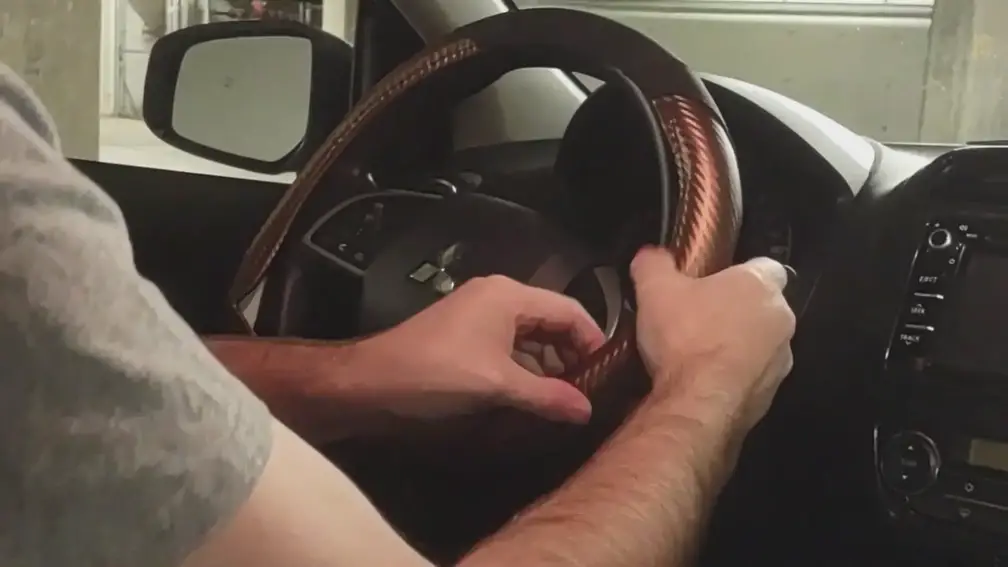IMPORTANT SAFETY INFORMATION
THIS IS A HEATING APPLIANCE
DO NOT OPERATE THIS APPLIANCE WITHOUT FRONT PANEL INSTALLED.
- Due to high temperatures the appliance should be located out of traffic and away from furniture and draperies.
- Children and adults should be alerted to the hazards of high surface temperatures and should stay away to avoid burns or clothing ignition.
- Young children should be carefully supervised when they are in the same room as the appliance.
- Clothing or other flammable material should not be placed on or near the appliance.
- Any safety screen or guard removed for servicing an appliance must be replaced prior to operating the appliance.
- Keep burner and control compartment clean.
- Vent cap hot while furnace is in operation.
- Installation and repair should be done by a QUALIFIED SERVICE PERSON. The appliance should be inspected before use and at least annually by a qualified service person.
- More frequent cleaning may be required due to excessive lint from carpeting, bedding materials, etc. It is imperative that control compartments, burners, and circulating air passageways of the appliance be kept clean.
- DO NOT put anything around the furnace that will obstruct the flow of combustion and ventilation air.
- DO keep the appliance area clear and free from combustible material, gasoline, and other flammable vapors and liquids.
- DO examine venting system periodically and replace damaged parts.
- DO examine burners periodically. Clean and replace damaged parts.
- CAUTION: Pilot hole cover must be kept tightly closed during operation.
- DO NOT use this heater if any part has been under water. Immediately call a qualified service technician to inspect the heater and to replace any part of the
control system and any gas control which has been under water.
SAFETY INFORMATION FOR USERS OF PROPANE GAS
Propane is a flammable gas which can cause fires and explosions. In its natural state, propane is odorless and colorless. You may not know all the following safety precautions which can protect both you and your family from an accident. Read them carefully now, then review them point by point with the members of your household. Someday when there may not be a minute to lose, everyone’s safety will depend on knowing exactly what to do. If, after reading the following information, you feel you still need more information, please contact your gas supplier.
PROPANE GAS WARNING ODOR
If a gas leak happens, you should be able to smell the gas because of the odorant put in the Propane Gas.
That’s your signal to go into immediate action!
- Do not operate electric switches, light matches, use your phone. Do not do anything that could ignite the gas.
- Get everyone out of the building, vehicle, trailer, or area. Do that IMMEDIATELY.
- Close all gas tank or cylinder supply valves.
- Propane Gas is heavier than air and may settle in low areas such as basements. When you have reason to suspect a gas leak, keep out of basements and other low areas. Stay out until firefighters declare them to be safe.
- Use your neighbor’s phone and call a trained Propane Gas service person and the fire department. Even though you may not continue to smell gas, do not turn on the gas again. Do not re-enter the building, vehicle, trailer, or area.
- Finally, let the service man and firefighters check for escaped gas. Have them air out the area before you return. Properly trained Propane Gas service people should repair the leak, then check and relight the gas appliance for you.
NO ODOR DETECTED – ODOR FADE
Some people cannot smell well. Some people cannot smell the odor of the chemical put into the gas. You must find out if you can smell the odorant in propane. Smoking can
decrease your ability to smell. Being around an odor for a time can affect your sensitivity or ability to detect that odor. Sometimes other odors in the area mask the gas odor.
People may not smell the gas odor or their minds are on something else. Thinking about smelling a gas odor can make it easier to smell.
The odorant in Propane Gas is colorless, and it can fade under some circumstances. For example, if there is an underground leak, the movement of the gas through soil can filter the odorant. Odorants in Propane Gas also are subject to oxidation. This fading can occur if there is rust inside the storage tank or in iron gas pipes.
The odorant in escaped gas can adsorb or absorb onto or into walls, masonry and other materials and fabrics in a room. That will take some of the odorant out of the gas, reducing its odor intensity.
Propane Gas may stratify in a closed area, and the odor intensity could vary at different levels. Since it is heavier than air, there may be more odor at lower levels. Always be sensitive to the slightest gas odor. If you detect any odor, treat it as a serious leak. Immediately go into action as instructed earlier.
SOME POINTS TO REMEMBER
- Learn to recognize the odor of Propane Your local Propane Gas Dealer can give you a “Scratch and Sniff” pamphlet. Use it to find out what the propane odor smells like. If you suspect that your Propane Gas has a weak or abnormal odor, call your Propane Gas Dealer.
- If you are not qualified, do not light pilot lights, perform service, or make adjustments to appliances on the Propane Gas If you are qualified, consciously think about the odor of Propane Gas prior to and while lighting pilot lights or performing service or making adjustments.
- Sometimes a basement or a closed-up house has a musty smell that can cover up the Propane Gas odor. Do not try to light pilot lights, perform service, or make adjustments in an area where the conditions are such that you may not detect the odor if there has been a leak of Propane Gas.
- Odor fade, due to oxidation by rust or adsorption on walls of new cylinders and tanks, is Therefore, people should be particularly alert and careful when new tanks or cylinders are placed in service. Odor fade can occur in new tanks, or reinstalled old tanks, if they are filled and allowed to set too long before refilling. Cylinders and tanks which have been out of service for a time may develop internal rust which will cause odor fade. If such conditions are suspected to exist, a periodic sniff test of the gas is advisable. If you have any question about the gas odor, call your Propane Gas Dealer. A periodic sniff test of the Propane Gas is a good safety measure under any condition.
- If, at any time, you do not smell the Propane Gas odorant and you think you should, assume you have a Then take the same immediate action recommended above for the occasion when you do detect the odorized Propane Gas.
- If you experience a complete “gas out,” (the container is under no vapor pressure), turn the tank valve off immediately. If the container valve is left on, the container may draw in some air through openings such as pilot light If this occurs, some new internal rusting could occur. If the valve is left open, then treat the container as a new tank. Always be sure your con- tainer is under vapor pressure by turning it off at the container before it goes completely empty or having it refilled before it is completely empty.
REQUIREMENTS FOR MASSACHUSETTS
For all side wall horizontally vented gas fueled equipment installed in every dwelling, building or structure used in whole or in part for residential purposes, including those owned or operated by the Commonwealth and where the side wall exhaust vent termination is less than seven (7) feet above finished grade in the area of the venting, including but not limited to decks and porches, the following requirements shall be satisfied:
- INSTALLATION OF CARBON MONOXIDE DETECTORS. At the time of installation of the side wall horizontal vented gas fu- eled equipment, the installing plumber or gasfitter shall observe that a hard wired carbon monoxide detector with an alarm and battery back-up is installed on the floor level where the gas equipment is to be In addition, the installing plumber or gasfitter shall observe that a battery operated or hard wired carbon monoxide detector with an alarm is installed on each additional level of the dwelling, building or structure served by the side wall horizontal vented gas fueled equipment. It shall be the responsibility of the property owner to secure the services of qualified licensed professionals for the installation of hard wired carbon monoxide detectors.
- In the event that the side wall horizontally vented gas fu- eled equipment is installed in a crawl space or an attic, the hard wired carbon monoxide detector with alarm and battery back-up may be installed on the next adjacent floor
- In the event that the requirements of this subdivision can not be met at the time of completion of installation, the owner shall have a period of thirty (30) days to comply with the above requirements; provided, however, that during said thirty (30) day period, a battery operated carbon monoxide detector with an alarm shall be
- APPROVED CARBON MONOXIDE Each carbon monoxide detector as required in accordance with the above provisions shall comply with NFPA 720 and be ANSI/UL 2034 listed and IAS certified.
- A metal or plastic identification plate shall be per- manently mounted to the exterior of the building at a minimum height of eight (8) feet above grade directly in line with the exhaust vent terminal for the horizontally vented gas fueled heating appliance or equipment. The sign shall read, in print size no less than one-half (1/2) inch in size, “GAS VENT DI- RECTLY BELOW. KEEP CLEAR OF ALL OBSTRUCTIONS”.
- The state or local gas inspector of the side wall horizontally vented gas fueled equipment shall not approve the installation unless, upon inspection, the inspector observes carbon monoxide detectors and signage installed in accordance with the provisions of 248 CMR 5.08(2)(a) 1 through 4.
- EXEMPTIONS: The following equipment is exempt from 248 CMR 08(2)(a)1 through 4:
- The equipment listed in Chapter 10 entitled “Equip- ment Not Required To Be Vented” in the most current edition of NFPA 54 as adopted by the Board; and
- Product Approved side wall horizontally vented gas fueled equipment installed in a room or structure separate from the dwelling, building or structure used in whole or in part for residential
- MANUFACTURER REQUIREMENTS – GAS EQUIPMENT VENTING SYSTEM When the manufacturer of Product Approved side wall horizontally vented gas equip- ment provides a venting system design or venting system components with the equipment, the instructions provided by the manufacturer for installation of the equipment and the venting system shall include:
- Detailed instructions for the installation of the venting system design or the venting system components; and
- A complete parts list for the venting system design or venting system.
(e) A copy of all installation instructions for all Product Approved side wall horizontally vented gas fueled equipment, all venting instructions, all parts lists for venting instructions, and/or all venting design instructions shall remain with the appliance or equipment at the completion of the installation.
Introduction
Always consult your local Building Department regarding regulations, codes or ordinances which apply to the installation of a direct vent wall furnace.
Instructions to Installer
- Installer must leave instruction manual with owner after
- Installer must have owner fill out and mail warranty card supplied with furnace.
- Installer should show owner how to start and operate
General Information
This furnace is design certified in accordance with American National Standard/CSA Standard Z21.86 and CSA 2.32 by the Canadian Standards Association, as a Gravity Direct Vent Wall Furnace to be installed on an outside wall according to these instructions.
Any alteration of the original design, installed other than as shown in these instructions or use with a type of gas not shown on the rating plate is the responsibility of the person and company making the change.
Important
All correspondence should refer to complete Model No., Serial No. and type of gas.
NOTICE: During initial firing of this unit, its paint will bake out and smoke will occur. To prevent triggering of smoke alarms, ventilate the room in which the unit is installed.
Installation in Residential Garages
Gas utilization equipment in residential garages shall be installed so that all burners and burner ignition devices are located not less than 18″ (457mm) above the floor.
Such equipment shall be located, or protected, so it is not subject to physical damage by a moving vehicle.
Qualified Installing Agency
Installation and replacement of gas piping, gas utilization equipment or accessories and repair and servicing of equipment shall be performed only by a qualified agency. The term “qualified agency” means any individual, firm, corporation or company which either in person or through a representative is engaged in and is responsible for
- the installation or replacement of gas piping or (b) the connection, installation, repair or servicing of equipment, who is experienced in such work, familiar with all precautions required and has complied with all the requirements of the authority having
Commonwealth of Massachusetts: The installation must be made by a licensed plumber or gas fitter in the Commonwealth of Massachusetts
The installation must conform with local codes or, in the absence of local codes, with the National Fuel Gas Code ANSI Z223.1/NFPA 54* Natural Gas and Propane Installation Code, CSA B149.1.
*Available from the American National Standards Institute, Inc., 11 West 42nd St., New York, N.Y. 10036.
High Altitudes
For altitudes/elevations above 2,000 feet (610m) , input ratings should be reduced at the rate of 4 percent for each 1,000 feet (305m) above sea level. Canadian High Altitudes for locations having an elevation above mean sea level between 2,000 feet (610m) and 4,500 feet (1370m), the manifold pressure is to be decreased from 4.0″ w.c. (.996kPa) to 3.2″ w.c. (.797kPa) for Natural Gas and from 10.0″ w.c. (2.49kPa) to 8.0″ w.c. (1.99kPa) for Propane Gas.
Installation on Rugs and Tile
If this appliance is to be installed directly on carpeting, tile, or other combustible material, other than wood flooring, the appliance shall be installed on a metal or wood panel extending the full width and depth of the appliance.
The base referred to above does not mean the fire-proof base as used on wood stoves. The protection is primarily for rugs that may be extremely thick and light-color tile that may discolor.
Well Head Gas Installations Some Natural Gas utilities use “well head” gas. This may affect the BTU output of the unit and promote sooting. Units shall not be converted to use well head gas.
This appliance is only for use with the type of gas indicated on the rating plate. This appliance is not convertible for use with other gases.
INTRODUCTION (CONT’D)
When an existing Category 1 heater is removed or replaced, the original venting system may no longer be sized to properly vent the attached appliances. Instructions shall also indicate effects of an
improperly sized venting system (formation of condensate, leakage,
spillage, etc.) and shall specify the following test procedure:
| WARNING
CARBON MONOXIDE POISONING HAZARD 1.Seal any unused openings in the venting system. 2. Inspect the venting system for proper size and at the draft hood relief opening after 5 minutes of main horizontal pitch, as required in the National Fuel Gas burner operation. Use the flame of a match or candle. Code, ANSI Z223.1/NFPA 54 or the Natural Gas and |
SPECIFICATIONS
| Model | DV-210 | DV-215 |
| Input BTU/HR (KW/H) | 10,000 (2.9) | 15,000 (4.4) |
| Height | 21 3/8″ (543mm) | 24 7/8″ (632mm) |
| Width | 16 1/4 (413mm) | 20 1/4″ (514mm) |
| Depth | 9 3/8″ (239mm) | 9 3/8″ (239mm) |
| Gas Inlet | 1/2″ (13mm) | 1/2″ (13mm) |
| OPTIONS FOR ABOVE FURNACES | ||
| Blower | DVB-1 | DVB-1 |
| VINYL SIDING VENT KITS | ||
| Description | Model Number | |
| Vinyl Siding Vent Kit | DV822 | DV822 |
| Vinyl Siding Vent Kit | VSK1 | VSK1 |
| VENT EXTENSION KITS | ||
| Part Number | Description | Used On |
| TH358 | Vent Extension Kit For Propane Units (13″-19″ Walls) | DV215SGXLP-1,2 |
| TH357 | Vent Extension Kit For Natural Units (13″-19″ Walls) | DV215SGXNAT-1,2 |
| TH345 & TH346 | Vent Extension (13″-19″ Walls) | DV210SGXNAT-2 DV210SGXLP-2 |
| CONVERSION KITS | ||
| Part Number | Description | Used On |
| 17081 | Propane to Natural | DV210SGXLP |
| 17080 | Natural to Propane | DV210SGXNAT |
| 17083 | Propane to Natural | DV215SGXLP |
| 17082 | Natural to Propane | DV215SGXNAT |
GAS SUPPLY
Locating Gas Supply
The gas line can enter the unit either through the floor or outside wall. The gas line opening should be made at this time. Location of the opening will be determined by the position of floor joists and the valve and union used for servicing.
| RECOMMENDED GAS PIPE DIAMETER | ||||
| Pipe Length | Schedule 40 Pipe Inside Diameter | Tubing, Type L Outside Diameter | ||
| Natural | Propane | Natural | Propane | |
| 0-10 feet
0-3 meters |
1/2”
12.7 mm |
3/8”
9.5mm |
1/2”
12.7 mm |
3/8”
9.5 mm |
| 10-40 feet
4-12 meters |
1/2”
12.7 mm |
1/2”
12.7mm |
5/8”
15.9 mm |
1/2”
12.7 mm |
| 40-100 feet
13-30 meters |
1/2”
12.7 mm |
1/2”
12.7mm |
3/4”
19 mm |
1/2”
12.7 mm |
| 100-150 feet
31-46 meters |
3/4”
19 mm |
1/2”
12.7 mm |
7/8”
22.2 mm |
3/4”
19 mm |
NOTE: Never use plastic pipe. Check to confirm whether your local codes allow copper tubing or galvanized.
NOTE: Since some municipalities have additional local codes, it is always best to consult your local authority and installation code.
The use of the following gas connectors is recommended:
- ANS 24 Appliance Connectors of Corrugated Metal Tubing and Fittings
- ANS 45 Assembled Flexible Appliance Connectors of Other Than All-Metal Construction
The above connectors may be used if acceptable by the authority having jurisdiction. The Commonwealth of Massachusetts requires that a flexible appliance connector cannot exceed three feet in length.

Consult the current National Fuel Gas Code, ANSI Z223.1 CAN/ CGA-B149 (.1 or .2) installation code.
Installing a New Main Gas Shut-Off
Each appliance should have its own manual gas shut-off.
A manual main gas shut-off should be located in the vicinity of the unit. Where none exists, or where its size or location is not adequate, contact your local authorized installer for installation or relocation. Compounds used on threaded joints of gas piping shall be resistant to the action of liquefied petroleum gases. The gas lines must be checked for leaks by the installer. This should be done with a soap.
solution watching for bubbles on all exposed connections, and if unexposed, a pressure test should be made.
Never use an exposed flame to check for leaks. Appliance must be disconnected from piping at inlet of control valve and pipe capped or plugged for pressure test. Never pressure test with appliance connected; control valve will sustain damage!
A gas valve and ground joint union should be installed in the gas line upstream of the gas control to aid in servicing. It is required by the National Fuel Gas Code that a drip line be installed near the gas inlet. This should consist of a vertical length of pipe tee connected into the gas line that is capped on the bottom in which condensation and foreign particles may collect.
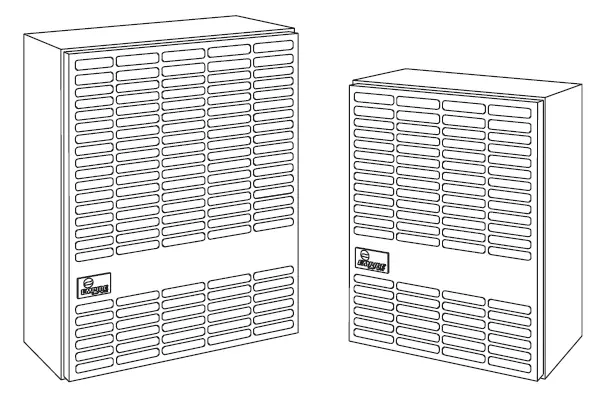
Method of Installing a Tee Fitting Sediment Trap
Pressure Testing of the Gas Supply System
- To check the inlet pressure to the gas valve, a 1/8″ (3mm) N.P.T. plugged tapping, accessible for test gauge connection, must be placed immediately upstream of the gas supply connection to the appliance.
- The appliance and its individual shut-off valve must be disconnected from the gas supply piping system during any pressure testing of that system at test pressures in excess of 1/2 psig (3.5 kPa).
- The appliance must be isolated from the gas supply piping system by closing its individual manual shut-off valve during any pressure testing of the gas supply piping system at test pressures equal to or less than 1/2 psig (3.5 kPa).
Attention! If one of the above procedures results in pressures in excess of 1/2 psig (14″ w.c.) (3.5 kPa) on the appliance gas
valve, it will result in a hazardous condition.
Checking Manifold Pressure
Both Propane and Natural Gas valves have a built-in pressure regulator in the gas valve. Natural Gas models will have a manifold pressure of approximately 4.0″ w.c. (.996kPa) at the valve outlet with the inlet pressure to the valve from a minimum of 5.0″ w.c. (1.245kPa) for the purpose of input adjustment to a maximum of 10.5″ w.c. (2.61kPa). Propane Gas models will have a manifold pressure approximately 10.0″ w.c. (2.49kPa) at the valve outlet with the inlet pressure to the valve from a minimum of 11.0″ w.c.
(2.739kPa) for the purpose of input adjustment to a maximum of 13.0″ w.c. (3.237kPa). A 1/8″ (3mm) N.P.T. plugged tapping, accessible for test gauge connection, is located on the outlet side of the gas control.
CLEARANCES
- In selecting a location for installation, it is necessary to provide adequate accessibility clearances for servicing and proper
- Although certified for 0 clearance to the floor , the unit is held in place by a wall Enough clearance [2″ (51mm) suggested] to allow changing or adding floor covering is recommended. Other clearances to combustible construction:
Sides 1″ (25mm) and 12″ (305mm) from the top.
- Note the position of the vent relative to the center of the unit. The DV-210 has the vent in the center. The DV-215 vent is 2″ (51mm) off center to the right.
- The minimum distance from the center of the outside vent to the nearest outside corner or obstruction is 16″ (406mm).
The DV-210/DV-215 minimum wall depth is 4 1/2″ (114mm) and maximum wall depth is 13″ (330mm). The use of tubes not supplied by the manufacturer result in unsatisfactory performance.
The vent terminal of a direct vent appliance, with an input of 10,000 Btu per hour (3 kW) or less shall be located at least 6″ (150mm) from any air opening into a building, and such an appliance with an input over 10,000 Btu per hour (3 kW) but not over 50,000 Btu per hour (14.7 kW) shall be installed with a 9″ (229mm) vent terminal clearance and the bottom of the vent terminal and the air intake shall be located at least 12″ (305mm) above grade.
The nearest point of the vent cap should be a minimum horizontal distant of six (6) feet (1.8m) from any pressure regulator. In case of regulator malfunction, the six feet (1.8m) distance will reduce the chance of gas entering the vent cap.
The maximum wall depth may be extended to 19″ (483mm) by us- ing the vent extension kits listed on page 7.
INSTALLATION INSTRUCTIONS
The furnace is to be located on an outside wall. Locate wall studs so that wall opening will be located between wall studs. One wall stud can be used for attachment of inside wall plate. The wall opening required as shown in Figure 3 is a minimum diameter of 6 1/4 (159mm) inches. The inside wall plate and the outside wall plate are large enough to permit a wall opening diameter of 8 inches (203mm). A template is provided in furnace carton for positioning furnace on the wall. Also, refer to Figure 3 for positioning the furnace on wall and for locating gas line connection.
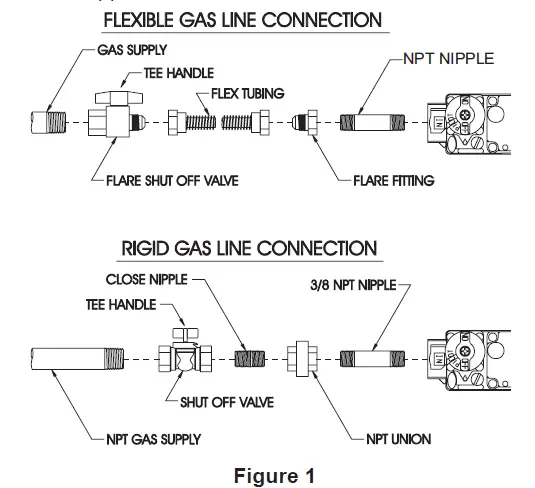
Installing Inside Wall Plate
After the wall opening has been located and cut, center and level inside wall plate in wall opening. The collar on the inside wall plate is to be placed within the wall opening. If there is insulation above the wall opening (air inlet tube) a barrier should be installed above the wall opening (air inlet tube) to prevent insulation from coming in contact with the air inlet tube. The barrier must not penetrate into the 6-1/4″ (159mm) diameter wall opening. On solid wall or wall stud, attach inside wall plate with (6) #10 x 1 1/2″ (38mm) screws provided. On sheet rock wall, by using wall opening for access, attach inside wall plate with (6) #10 x 1 1/2″ (38mm) screws and (6) Tinnerman nuts provided.
Attaching Furnace To Inside Wall Plate
Align and attach mounting clips on furnace back with mounting slots on inside wall plate. The furnace support bracket located at furnace bottom is to be secured to wall. On solid wall, secure furnace support bracket with (1) #10 x 1 1/2″ (38mm) screw provided. On sheet rock wall, secure furnace support bracket with (1) toggle bolt provided.
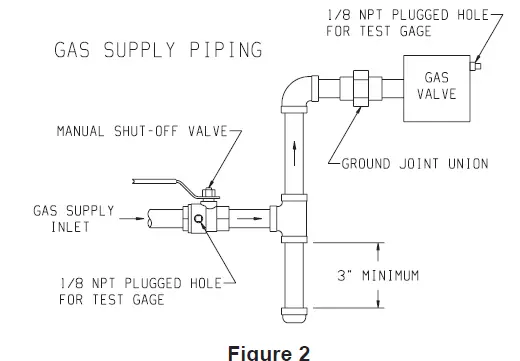
INSTALLATION INSTRUCTIONS (CONT’D)
Cutting Vent Tubes
This is the most important part of the installation. With the furnace installed on wall the 5″ (127mm) diameter air inlet tube and 3″ (76mm) diameter flue outlet tube are to be marked and cut using the following procedure.
- Attach 5″ (127mm) diameter air inlet tube onto the collar of air drop Be sure 5″ (127mm) diameter air inlet tube is placed as far as possible onto the collar of the air drop assembly. Mark the 5″ (127mm) diameter air inlet tube 1/2″ (13mm) beyond the outside wall. Remove 5″ (127mm) diameter air inlet tube from collar of air drop assembly.
- Attach 3″ (76mm) diameter flue outlet tube onto flue outlet collar on combustion Be sure 3″ (76mm) diameter flue outlet tube is placed as far as possible onto the collar of flue outlet. Mark the 3″ (76mm) diameter flue outlet tube 2″ (51mm) beyond the outside wall. Remove 3″ (76mm) diameter flue outlet tube from collar of flue outlet on combustion chamber.
- Mark or wrap tape completely around the tubes at the marked points to help in making a true Do not crimp or enlarge tubes.
Installing The Vent Assembly
- Place caulking (not provided) beneath the edge of the outside wall Use additional caulking to correct uneven wall surface, such as clapboard.
- Attach 5″ (127mm) diameter air inlet tube onto the collar of air drop assembly. Attach caulked, outside wall plate into the 5″ (127mm) diameter air inlet Position the outside wall plate so that 5″ (127mm) diameter air inlet tube has a slight downward slope to the outside. The downward slope is necessary to prevent the entry of rainwater. Attach outside wall plate to exterior wall with (4) #10 x 1 1/2″ (38mm) screws provided.
- Apply furnace cement to 3″ (76mm) diameter flue outlet collar on combustion chamber and to 3″ (76mm) diameter collar on vent cap. Attach 3″ (76mm) diameter flue outlet tube onto flue outlet collar on combustion chamber. Attach vent cap into the 3″ (76mm) diameter flue outlet Attach vent cap to outside wall plate with (3) #10 x 1/2″ (13mm) screws provided.
- Installation is completed
Reassembly And Resealing Vent-Air Intake System
When vent-air intake system is removed for servicing the furnace, the following steps will assure proper reassembly and resealing of the vent-air intake assembly.
- Remove old furnace cement from flue outlet collar on combustion chamber and collar of vent cap. Remove old furnace cement from both ends of 3″ (76mm) diameter flue outlet
- Remove old caulking beneath the edge of the outside wall Apply new caulking beneath the edge of the outside wall plate. Use additional caulking to correct uneven wall surface, such as clapboard.
- Attach 5″ (127mm) diameter air inlet tube onto the collar of air drop assembly. Attach caulked, outside wall plate into the 5″ (127mm) diameter air inlet Position the outside wall plate so that 5″ (127mm) diameter air inlet tube has a slight downward slope to the outside. The downward slope is necessary to prevent the entry of rainwater. Attach outside wall plate to exterior wall with (4) #10 x 1″ (25mm) screws provided.
- Apply furnace cement to 3″ (76mm) diameter flue outlet collar on combustion chamber and to 3″ (76mm) diameter collar on vent cap. Attach 3″ (76mm) diameter flue outlet tube onto flue outlet collar on combustion chamber. Attach vent cap into the 3″ (76mm) diameter flue outlet Attach vent cap to outside wall plate with (3) #10 x 1/2″ (13mm) screws provided.
- Reassembly and resealing vent-air intake system is
Installing a Vent Near a Window Ledge, Other Type of Projection or on Siding (vinyl, aluminum, etc.)
Direct vent furnaces are designed to be installed on a uniform outside wall. When the wind comes from any angle (up, down or from either side), it must hit the vent cap equally over both the air inlet and the flue outlet portions of the vent. Any wall projection, such as a door or window casing, which disturbs the wind on one side of the air inlet section will result in back pressure on the flue section smothering the flame and eventual pilot outage.
When the vent cap is to be installed on siding or it appears that a projection within 6″ (152mm) of any side of the air inlet section could shield the air inlet section, the entire vent should be supported away from the wall at least the distance of the projection. 2″ x 4″ (51mm x 102mm) framing whose outside dimensions match the overall dimensions of the mounting plate is recommended. The 2″ x 4″ (51mm x 102mm) framing protects siding from possible warpage or discoloration. All joints can then be sealed and painted. The wall depth plus the additional depth of the 2″ x 4″ (51mm x 102mm) framing should not exceed a total depth of 13″ (330mm) for DV-210/ DV-215. See Figure 5

Vinyl siding vent kit, DV-822, is available from Empire Comfort Systems, Inc. The depth is 3″ (76mm), which enables the vent cap to be extended away from siding or projections. The wall depth plus the additional 3″ (76mm) depth of the vinyl siding vent cap extension should not exceed a total depth of 13″ (330mm) for DV-210/DV-215. See Figure 5a.
 WARNING
WARNING
When vinyl siding vent kit, DV-822 or 2″ x 4″ (51mm x 102mm) framing is added to an existing installation (furnace is installed) do not attempt to add sections of pipe to the flue outlet tube or air inlet tube. An air tight seal is required for both tubes. Refer to Parts List, page 14 to order tubes.
LIGHTING INSTRUCTIONS
FOR YOUR SAFETY READ BEFORE LIGHTING
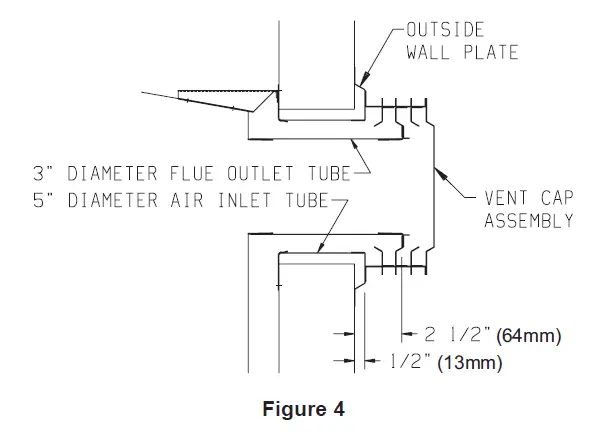 WARNING
WARNING
If you do not follow these instructions exactly, a fire or explosion may result causing property damage, personal injury or loss of life.
- This appliance has a pilot which must be lighted by Use only your hand to push in or turn the gas control hand. When lighting the pilot, follow these instructions knob. Never use tools. If the knob will not push in exactly .or turn by hand, don’t try to repair it; call a qualified
- BEFORE LIGHTING smell all around the appliance area service Force or attempted repair may
for gas. Be sure to smell next to the floor because some result in a fire or explosion.
gas is heavier than air and will settle on the floor.
D. Do not use this appliance if any part has been under WHAT TO DO IF YOU SMELL GAS water. Immediately call a qualified service technician
- Do not try to light any to inspect the appliance and to replace any part of
- Do not touch any electrical switch; the control system and any gas control which has
do not use any phone in your building. been under water.
- Immediately call your gas supplier from a neighbor’s Follow the gas supplier’s instructions.
- If you cannot reach your gas supplier, call the fire department.
LIGHTING INSTRUCTIONS
- STOP! Read the safety information above.
- Turn off all electric power to the appliance (if applicable).
- Remove control access panel (front panel).
- Push in gas control knob slightly and turn clockwise
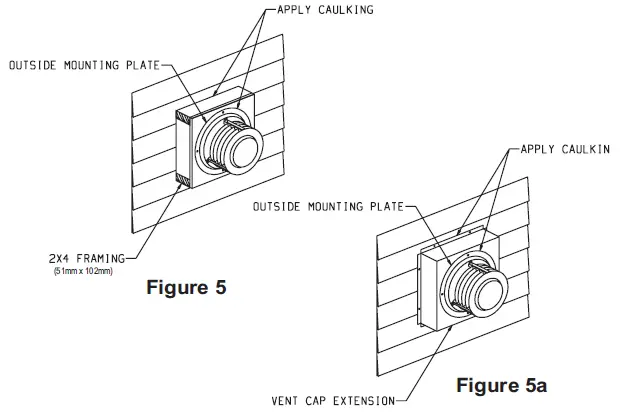
NOTE: Knob cannot be turned from “PILOT” to “OFF” unless knob is pushed in slightly. Do not force. - Wait ten (10) minutes to clear out any gas. Then smell for gas, including near the floor. If you smell gas, STOP! Follow “B” in the safety information above. If you don’t smell gas, go to the next step
- Remove the pilot access cover located on the combustion chamber.
- Find pilot – follow metal tube from gas control. The pilot is behind the pilot access cover.
- Turn knob on gas control counterclockwise to “PILOT.”
- Push in control knob all the way and hold in. Immediately light the pilot with the Piezo Pilot Ignitor or a match. Continue to hold the control knob in for about one (1) minute after the pilot is lit. Release knob, and it will pop back up. Pilot should remain lit. If it goes out, repeat steps 5 through 10.
• If knob does not pop up when released, stop and immediately call your service technician or gas supplier.
• If the pilot will not stay lit after several tries, turn the gas control knob to “OFF” and call your service technician or gas supplier. - Replace pilot access cover.
- Turn gas control knob counterclockwise to “ON.”
- Replace control access panel (front panel).
- Turn on all electric power to the appliance (if applicable).
- CAUTION: Pilot access cover must be kept tightly closed during operation.
TO TURN OFF GAS TO APPLIANCE
- Turn off all electric power to appliance if service is to be performed (if applicable).
- Remove control access panel (front panel).
- Push in gas control knob slightly and turn clockwise to “OFF.” Do not force.
- Replace control access panel (front panel).
MAINTENANCE
These heaters are specially designed for use on self generating systems. They should never be used on line or low voltage A.C. circuits.
Installing the ON/OFF Device
To install an ON/OFF device (such as a wall switch, remote, toggle switch,or thermostat), remove the wire nut from the two wires from the valve. Run additional wire from the valve wires to the ON/OFF device. Install the ON/OFF device in the same room as the furnace following the installation instructions supplied with it. In the absence of instructions, install the ON/OFF device 4 to 5 feet above the floor on an interior wall not affected by another heating source (i.e. stove or water heater) or the temperature of an adjoining room..
System Check
A millivolt meter is required to check the system. The millivolt
readings should be:
- Across the thermopile terminals, 400-450 millivolts with the heater
- Across the thermopile terminals, 150-250 millivolts with the heater
- Across the wires at the valve, less than 30 millivolts with the heater
Steps in Removing Main Burner, Orifice and Valve
- Disconnect the thermopile and pilot supply line at the pilot
- Remove the burner compartment cover 5/16″ (8mm) socket
- Remove screw holding left side of burner and lift
- Main burner orifice is now Use 1/2″ (13mm) box end wrench to remove and apply non-hardening pipe dope sparingly to orifice threads when replaced.
- To remove the entire gas valve the nut holding the orifice fitting to the chamber must be removed and the gas supply to the valve disconnected. After this, the valve and orifice elbow can be removed as a
Cleaning The Pilot Burner
Proper operation depends on a good pilot flame. The flame must cover the top of the thermopile. Cleaning of the pilot may be an annual necessity due to spiders. After removing the supply tubing and orifice, use a pipe cleaner or wire to clean the entire internal part of the pilot.
Cleaning the Combustion Chamber and Main Burner
When the main burner and vent cap are removed, all internal areas of the combustion chamber are accessible for cleaning with a vacuum hose. The main burner may be cleaned by forcing water into the ports and the throat of the burner. The burner should be blown dry or heated to dry all water out before reinstalling.
Piezo Pilot Ignitor Instructions
Depressing the piezo ignitor button completely causes a spark to occur at the pilot. This is a substitute for a match which requires opening the pilot hole cover.
To light the pilot, it is important that the electrode be 1/8″ (3 mm) from the thermopile. The spark must occur at the point the burner flame hits the thermopile. The end of the electrode will be red hot with the pilot on.
On a new installation with air in the gas line, it is suggested that a match be used. The match will light the pilot faster than the piezo under this condition.

PILOT FLAME CHARACTERISTICS
The pilot flame is blue and goes toward the main burner and thermopile horizontally. A slight yellow tip on the flame is normal. The pilot flame must surround and extend approximately 1/4″ (6mm) beyond the thermopile, and must extend beyond the first row toward the second row of main burner ports.

MAIN BURNER FLAME CHARACTERISTICS
On the main burner, the burning gas forms a primary flame and a secondary flame. The primary flame is blue and about 3/16″ (5mm) high. The secondary flame is very pale blue, 3 inches (76mm) to 5 inches (127mm) high. Dust in the combustion air will produce an orange flame. Do not mistake it for an improper yellow flame.

TROUBLESHOOTING
- Lit match goes out as it enters lighter
- Certain wind conditions will blow out Ignite
match, and as it flares, thrust match through opening.
- Certain wind conditions will blow out Ignite
- Open nearby door or window and relight
- Pilot flames but goes out when knob is
- See Lighting Relight Pilot.
- Relight the pilot and hold knob down longer and harder. Close lighter hole cover just after igniting. Check for a good pilot
- Defective thermopile or defective magnet in safety section of Replace.
- Yellow pilot
- Obstruction at pilot
- Clean and properly size
- Pilot and main burner go out during normal
- Check
- Check for proper size of pilot
- Check for defective or weak
- Check input, reduce as
- Cover on pilot lighter hole must be air
- Check for tight fit of air and flue tubes at both ends of vent No obstruction around vent that would prevent the wind from hitting all of the vent equally.
- Yellow main burner flame soot on the vent
- Remove main burner to check for obstructions in throat, ports and orifices.
- Install new main burner orifice and pilot Refer to Parts List on Page 14.
PARTS LIST

PARTS VIEW
MODEL DV-210 SHOWN
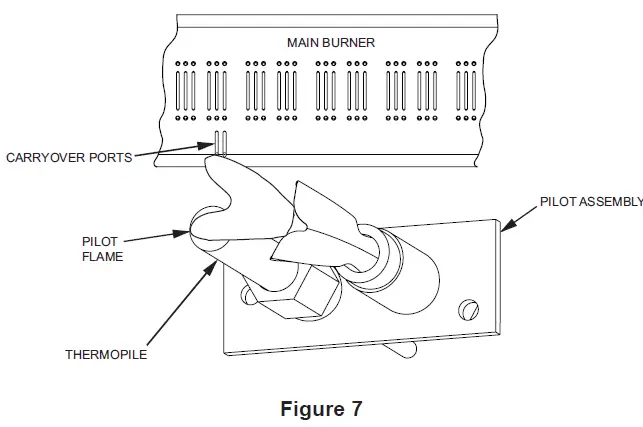
OPTIONAL BLOWER INSTALLATION INSTRUCTIONS
DVB-1 For Direct Vent Wall Furnaces DV210 and DV215
INSTALLING OPTIONAL BLOWER DVB-1. The blower must be positioned as shown in Figure 1. Relocate gas line, if necessary, using elbow fitting at the gas valve, and move Piezo Spark Genera- tor to the next screw. A slot on the bottom of the blower package engages a tab on the bottom of the inner casing and is secured by one screw in front.
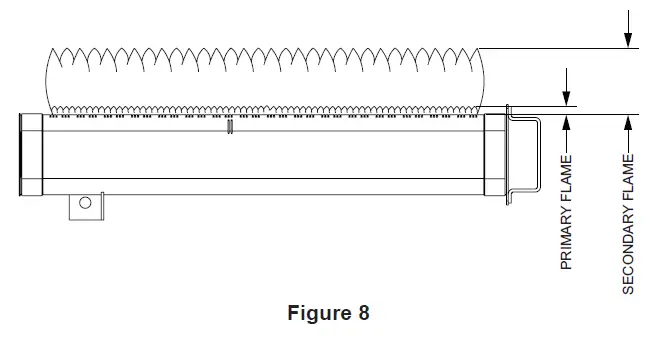
Attaching Switch Box
- Facing combustion chamber, remove (2) top, left screws on the combustion chamber door.
- Align (2) clearance holes on the switch box (with fan control) over (2) clearance holes on the combustion chamber
- Insert and attach (2) screws removed in Step 1 into switch box and combustion chamber door.
- Attach switch box cover to switch box with (1) 8 x 1/4″ screw.
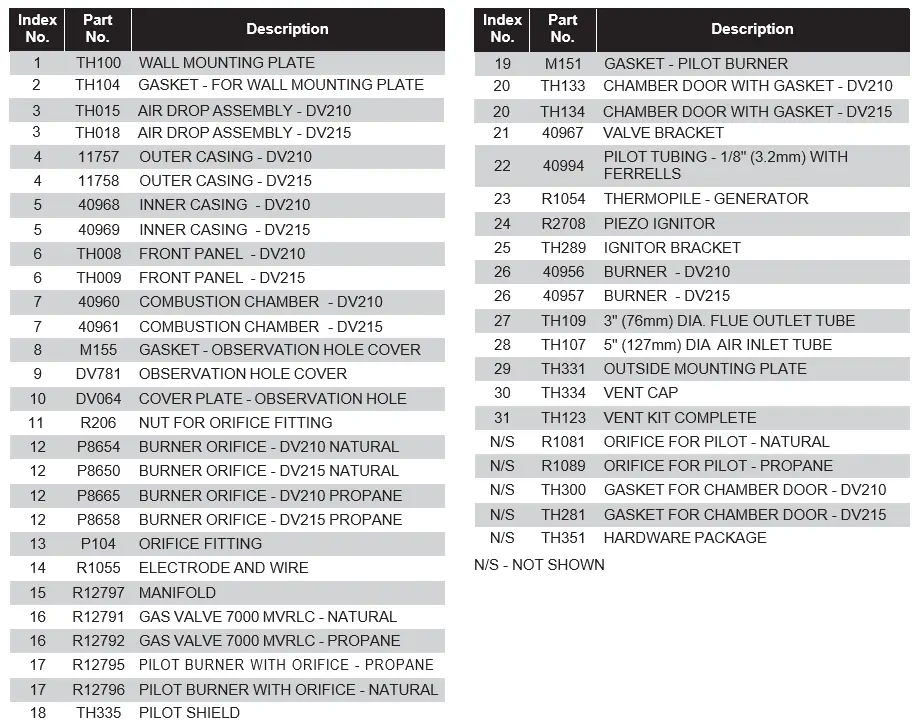
Wiring
The appliance, when installed, must be electrically grounded in accordance with local codes or, in the absence of local codes, with the National Electrical Code, ANSI/NFPA 70 or Canadian Electrical Code, CSA C22.1, if an external electrical source is utilized. This appliance is equipped with a three-prong [grounding] plug for your protection against shock hazard and should be plugged directly into a properly grounded three-prong receptacle. Do not cut or remove the grounding prong from this plug. For an ungrounded receptacle, an adapter, which has two prongs and a wire for grounding, can be purchased, plugged into the ungrounded receptacle and its wire connected to the receptacle mounting screw. With this wire completing the ground, the appliance cord plug can be plugged into the adapter and be electrically grounded. A 7/8″ (22mm) hole is provided in the junction box for use with a conduit connector if local codes require this type of protection.
CAUTION
Label all wires prior to disconnection when servicing controls. Wiring errors can cause improper and dangerous operation. Verify proper operation after servicing
NOTICE: Unplugging of blower accessory will not stop the heater from cycling. To shut heater off, turn knob on gas control to off, depressing slightly. Do not force.
Attaching Switch Box
- Facing combustion chamber, remove (2) top, left screws on the combustion chamber door.
- Align (2) clearance holes on the switch box (with fan control) over (2) clearance holes on the combustion chamber
- Insert and attach (2) screws removed in Step 1 into switch box and combustion chamber door.
- Attach switch box cover to switch box with (1) 8 x 1/4″ screw.
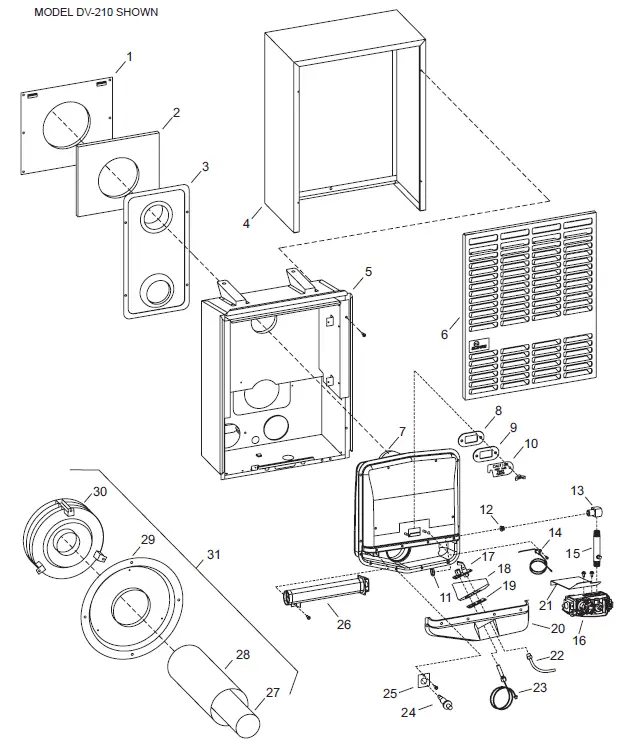
| Index No. | Part No. | Description |
| 1 | R-1268 | Wire Assembly |
| 2 | R-896 | Bushing (Three Required) |
| 3 | R-1156 | Fan Control |
| 4 | DV-806 | Switch Box |
| 5 | DV-807 | Switch Box Cover |
| 6 | TH-111 | Junction Box |
| 7 | R-1410 | Bushing (Strain Relief) |
| 8 | R-285 | Motor |
| 9 | R-587 | Motor Cushion |
| 10 | TH-341 | Blower Cushion |
| 11 | TH-356 | Motor Support Assembly |
| 12 | R-319 | Blower Wheel |
| 13 | TH-135 | Blower Housing Assembly |
| 14 | R-315 | Cord Set |
MASTER PARTS DISTRIBUTOR LIST
To Order Parts Under Warranty, please contact your local Empire dealer. See the dealer locator at www.empirecomfort. com. To provide warranty service, your dealer will need your name and address, purchase date and serial number, and the nature of the problem with the unit.To Order Parts After the Warranty Period, please contact your dealer or one of the Master Parts Distributors listed below. This list changes from time to time. For the current list, please click on the Master Parts button at www.empirecomfort.com. Please note: Master Parts Distributors are independent businesses that stock the most commonly ordered Original Equip- ment repair parts for Heaters, Grills, and Fireplaces manufactured by Empire Comfort Systems Inc.
MASTER PARTS DISTRIBUTOR LIST
Parts Not Under Warranty
Parts can be ordered through your Service Person, Dealer, or a Master Parts Distributor. See this page for the Master Parts Distribu- tors list. For best results, the service person or dealer should order parts through the distributor. Parts can be shipped directly to the service person/dealer.
Warranty Parts
Warranty parts will need a proof of purchase and can be ordered by your Service Person or Dealer. Proof of purchase is required for warranty parts.
All parts listed in the Parts List have a Part Number. When ordering parts, first obtain the Model Number and Serial Number from the name plate on your equipment. Then determine the Part Number (not the Index Number) and the Description of each part from the fol- lowing illustration and part list. Be sure to give all this information . . .
Appliance Model Number Part Description Appliance Serial Number Part Number Type of Gas (Propane or Natural)
Do not order bolts, screws, washers or nuts. They are standard hardware items and can be purchased at any local hardware store.
Shipments contingent upon strikes, fires and all causes beyond our control.
WARRANTY
Empire Comfort Systems Inc. warranties this space heating product to be free from defects at the time of purchase and for the periods specified below. Space heating products must be installed by a qualified technician and must be maintained and operated safely, in accordance with the instructions in the owner’s manual. This warranty applies to the original purchaser only and is not transferable. All warranty repairs must be accomplished by a qualified gas appliance technician.
Limited Ten-Year Parts Warranty – Combustion Chamber
Empire promises to the owner that if the combustion chamber (see parts list) fails because of defective workmanship or material with ten years from the date of purchase, Empire will repair or replace at Empire’s option.
Limited One-Year Parts Warranty – Remote Controls, Accessories, and Parts
Should any remote control, accessory, or other part fail because of defective workmanship within one year from the date of purchase, Empire will repair or replace at Empire’s option.
Duties Of The Owner
The appliance must be installed by a qualified installer and operated in accordance with the instructions furnished with the appliance. A bill of sale, cancelled check, or payment record should be kept to verify purchase date and establish warranty period. Ready access to the appliance for service.
What Is Not Covered
Damages that might result from the use, misuse, or improper installation of this appliance. Travel, diagnostic costs and freight charges on warranted parts to and from the factory.
Claims that do not involve defective workmanship or materials. Unauthorized service or parts replacements. Removal and reinstallation cost.
Inoperable due to improper or lack of maintenance.
How To Get Service
To make a claim under this warranty, please have your receipt available and contact your installing dealer. Provide the dealer with the model number, serial number, type of gas, and purchase verification. The installing dealer is responsible for providing service and will contact the factory to initiate any warranted parts replacements. Empire will make replacement parts available at the factory. Shipping expenses are not covered.
If, after contacting your Empire dealer, service received has not been satisfactory, contact: Consumer Relations Department, Empire Comfort Systems Inc., PO Box 529, Belleville, Illinois 62222, or send an e-mail to [email protected] with “Consumer Relations” in the subject line.
Your Rights Under State Law
This warranty gives your specific legal rights, and you may also have other rights, which vary from state to state.
]]>